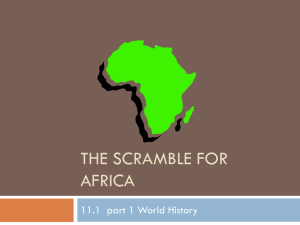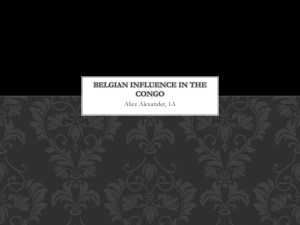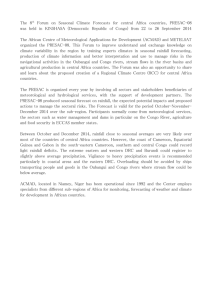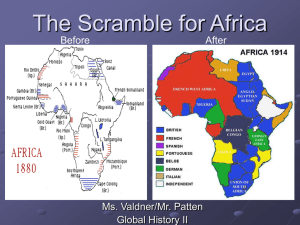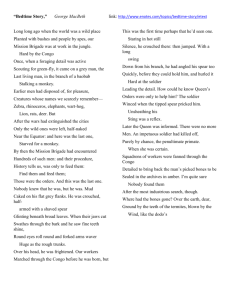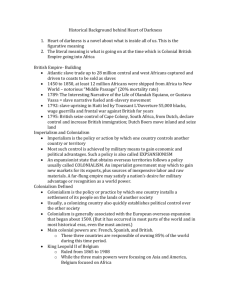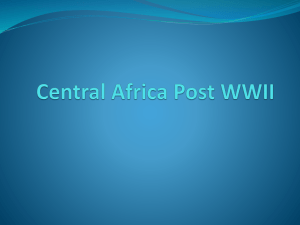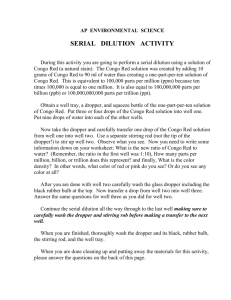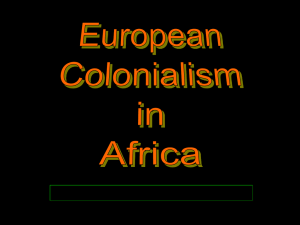Leopold`s Congo: A Story Hidden in Darkness Elena Martinez
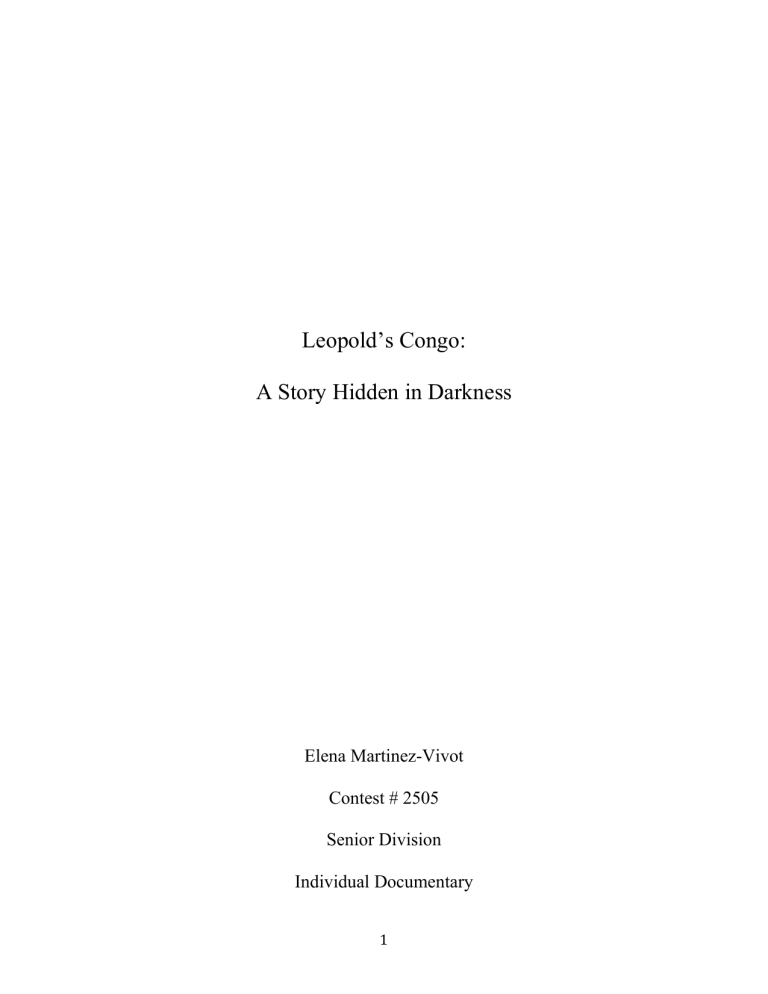
Leopold’s Congo:
A Story Hidden in Darkness
Elena Martinez-Vivot
Contest # 2505
Senior Division
Individual Documentary
1
As soon as I knew what the theme was this year, I knew exactly what I wanted to do. I had grown great interest for the Congo because my French teacher is from Congo.
Originally I wanted to do my project about the Rwandan and Congolese genocide, but this topic is not 25 years old. I was still determined to do a topic regarding Africa, so I asked my French teacher, and she told me about King Leopold and the genocide he caused. This topic greatly interested me, so I decided to research it.
I began my research by going to a series of online databases, such as Gale,
History In Context, and several others that I could access through my school and Public
Library System. A history teacher at my school was also able to loan me several books on the topic as well. Initially, I did not realize how difficult my topic was to research. It was specifically challenging to find primary sources because many documents of the time were either burned or are in French. To find all the primary resources necessary, I had to travel to other cities and use the available archives there. I organized my research by creating groups of notecard on the website Easybib, that then allowed me to create an outline with notecards.
I selected the presentation category of a documentary because I wanted to incorporate the interviews I had taken. I was already familiar with the process of creating videos from prior projects, so it was confident with the category I chose. I created the documentary I using a combination of iMovie and iPhoto. During the process of writing my script I matched photos from my outline to specific parts of the dialogue. My music came from the website Jamendo, that provides free non-copyrighted music. The final
2
process of my project was creating an annotated bibliography and writing my process paper.
King Leopold’s rule in the Congo can directly relate to this year’s theme, Rights and Responsibilities, for several reasons. Leopold stripped the indigenous people of the rights granted to them by the Act of Berlin, and he is responsible for the death of ten million people.
3
Annotated Bibliography
Primary Sources
The Act of Berlin . 1919. Library of Congess, Washington D.C. Open Library . Web. 25
Feb. 2014.
< https://openlibrary.org/books/OL7068177M/The_Belgian_Congo_and_the_Berli n_act >.
I used this source to provide one of the many pictures I used in my documentary.
Pictures are a great primary source because they provide direct insight on the time.
Astrada, Walter. Conflict in the Congo . 2008. Boston.com
. Web. 25 Feb. 2014.
< http://www.boston.com/bigpicture/2008/11/conflict_in_congo_refugees_on.html
>.
I used this source to provide one of the many pictures I used in my documentary.
Pictures are a great primary source because they provide direct insight on the time.
Barba, Georges. Map of Belgium . 1854. Miklian Maps, Luxemburg. Miklian Antiquarian
Maps . Web. 25 Feb. 2014. < http://www.miklianmaps.com/index.php
>.
I used this source to provide one of the many pictures I used in my documentary.
Pictures are a great primary source because they provide direct insight on the time.
The Berlin Conference 1884 . 1884. Wikimedia Commons . Web. 25 Feb. 2014.
< https://commons.wikimedia.org/wiki/File:Berlin_Conference_1884.jpg
>.
4
I used this source to provide one of the many pictures I used in my documentary.
Pictures are a great primary source because they provide direct insight on the time.
Boulger, Demetrius C. "The Congo State and Central-African Problems." Harper's New
Monthly Magazine Dec. 1899: 373-88. Print.
Because this article was published in 1899, it is a perfect primary source that provides insight on the view of a foreigner. This article discusses much about the customs of the Congolese people at the time and what sorts of products were produced in the Congo. This provide me with background information on the
Congo for my documentary.
Chandel, Tarun. Arc De Triomphe Brussels, Belgium . 2010. Tarun Chandel's Photoblog .
Web. 25 Feb. 2014. < http://photos.tarunchandel.com/2010/07/arc-de-triomphebrussels-belgium.html
>.
I used this source to provide one of the many pictures I used in my documentary.
Pictures are a great primary source because they provide direct insight on the time.
Child Soldier . 2012. Buzz Kenya . Web. 25 Feb. 2014. < http://buzzkenya.com/childsoldiers-uganda/ >.
I used this source to provide one of the many pictures I used in my documentary.
Pictures are a great primary source because they provide direct insight on the time.
5
Clearing of Farming Village . 1892. Wikimedia Commons . Web. 25 Feb. 2014.
< https://commons.wikimedia.org/wiki/File:ELdelCongo.jpg
>.
I used this source to provide one of the many pictures I used in my documentary.
Pictures are a great primary source because they provide direct insight on the time.
Collecting Rubber . 1889. WIkimedia Commons . Web. 25 Feb. 2014.
< https://commons.wikimedia.org/wiki/File:StoryoftheCongoFreeState_280.jpg
>.
I used this source to provide one of the many pictures I used in my documentary.
Pictures are a great primary source because they provide direct insight on the time.
"Editorials." Nation 23 Dec. 1909: 616. MasterFILE Premier. Web. 21 Oct. 2013.
This article was published right after Leopold's death and follows his legacy in the
Congo. This was helpful because it was very critical of his regime. I was able to use this information to provide insight on the opinion of the international community.
Germany. General Act of the Conference of Berlin: Signed February 26, 1885.
London:
Harrison and Sons, 1886. Print.
This source provided me with the Act of Berlin created in 1885. Several of the articles in the act were helpful in proving what laws Leopold broke, and what was expected of Leopold from the international community.
6
Glave, E. J. "Cruelty in the Congo Free State- Concluding Extracts from the Journals of
The Late E.J. Glave." The Century Illustrated Monthly Magazine May 1897: 699-
714. Print.
E.J. Glave was a man who travelled to the Congo in the late 1800’s. His journals were then published in this very helpful article describing a first hand account of the atrocities in the Congo. By having a first-hand account I was able to strengthen my argument. I used this in my project as proof of what leopold did.
Henry Morton Stanley . 1887. NNDB . Web. 25 Feb. 2014.
< http://www.nndb.com/people/284/000092008/ >.
I used this source to provide one of the many pictures I used in my documentary.
Pictures are a great primary source because they provide direct insight on the time.
Henry Morton Stanley . 1899. Web. < http://www.nndb.com/people/284/000092008/ >.
I used this source to provide one of the many pictures I used in my documentary.
Pictures are a great primary source because they provide direct insight on the time.
Henry Morton Stanley with Kalulu
. 1875. Archives of Charles Scribner’s Sons,
Manuscripts Division, London. Henry Morton Stanley 1841-1904 . Web. 25 Feb.
2014.
< http://libweb5.princeton.edu/visual_materials/maps/websites/africa/stanley/stanle y.htm
>.
7
I used this source to provide one of the many pictures I used in my documentary.
Pictures are a great primary source because they provide direct insight on the time.
Hotel Van Eetvelde Interior . 1903. Brussels. Wikimedia Commons . Web. 25 Feb. 2014.
< http://commons.wikimedia.org/wiki/File:Hotel_van_Eetvelde,_Victor_Horta.jpg
>.
I used this source to provide one of the many pictures I used in my documentary.
Pictures are a great primary source because they provide direct insight on the time.
Kasal, Odette. "The Congo Today." Personal interview. 21 Nov. 2013.
As a refugee, Mrs. Kasal has first hand experience of what horrors have been caused by the rule of the Belgians. Her opinion is very important because Congo is her homeland.
King Leopold II . 1830. Belgium Wins Its Independence . Web. 25 Feb. 2014.
< http://freepages.genealogy.rootsweb.ancestry.com/~noemeetjesland/1830/1830_0
9.htm
>.
I used this source to provide one of the many pictures I used in my documentary.
Pictures are a great primary source because they provide direct insight on the time.
La Force Publique . 1886. Military Sun Helmets . Web. 25 Feb. 2014.
< http://www.militarysunhelmets.com/2013/colonial-pattern-helmets-of-the-forcepublique >.
8
I used this source to provide one of the many pictures I used in my documentary.
Pictures are a great primary source because they provide direct insight on the time.
Le Funerailles De Leopold II, Roi Des Belges . 1909. Brussels. Wikimedia Commons .
Web. 25 Feb. 2014.
< https://commons.wikimedia.org/wiki/File:Solemn_Funeral_of_King_Leopold_II.
jpg >.
I used this source to provide one of the many pictures I used in my documentary.
Pictures are a great primary source because they provide direct insight on the time.
Map of Congo Free State 1906 . 1906. New Society for Diffusion of Knowledge . Web. 25
Feb. 2014.
< http://www.probertencyclopaedia.com/photolib/maps/Map_of_Congo_Free_Stat e_1906_(Zaire,_Democratic_Republic_of_the_Congo).htm
>.
I used this source to provide one of the many pictures I used in my documentary.
Pictures are a great primary source because they provide direct insight on the time.
Mutilated Children From Congo . 1903. King Leopold's Soliloquy: A Defense of His
Congo Rule. Wikipedia . Web. 25 Feb. 2014.
< http://en.wikipedia.org/wiki/File:MutilatedChildrenFromCongo.jpg
>.
I used this source to provide one of the many pictures I used in my documentary.
Pictures are a great primary source because they provide direct insight on the time.
9
Photograph of Leopold II of Belgium as Garter Knight . 1895. Wikipedia . Web. 25 Feb.
2014. < http://en.wikipedia.org/wiki/File:Leopold_ii_garter_knight.jpg
>.
I used this source to provide one of the many pictures I used in my documentary.
Pictures are a great primary source because they provide direct insight on the time.
Porters in the Congo . 1889. The Congo Free State: King Leopold's Plantation . Web. 25
Feb. 2014 .
< http://cobweb.sfasu.edu/sbradley/Classes/homepages/Congo_Free_State/ >.
I used this source to provide one of the many pictures I used in my documentary.
Pictures are a great primary source because they provide direct insight on the time.
Rubber Plantation Laborers Held Captive In Chains . 1883. Leopold II and the Congo
Free State . Web. 25 Feb. 2014.
< http://leopoldandcongo.wiki.elanco.net/Problems+for+Belium ...>.
I used this source to provide one of the many pictures I used in my documentary.
Pictures are a great primary source because they provide direct insight on the time.
Severed Hand . 1887. Mike Miesen . Web. 24 Feb. 2014.
< http://www.mikemiesen.com/2013/05/14/book-blogging-king-leopolds-ghost/ >.
I used this source to provide one of the many pictures I used in my documentary.
Pictures are a great primary source because they provide direct insight on the time.
10
Stanley, Henry Morton. Execution of Slaves by the Wakuti, Near Equator Station . 1885.
Wikimedia Commons . Web. 25 Feb. 2014.
< http://commons.wikimedia.org/wiki/File:Stanley_Founding_of_Congo_Free_Stat e_182_Execution_of_Slaves_by_the_Bakuti_near_Equator_Station.jpg
>.
I used this source to provide one of the many pictures I used in my documentary.
Pictures are a great primary source because they provide direct insight on the time.
Stanley, Henry Morton. Stanley Founding of Congo Free State An Interview Before The
Chiefs House at Wangata . 1885. The Congo and the Founding of Its Free State; a
Story of Work and Exploration (1885). Wikimedia Commons . Web. 25 Feb. 2014.
< http://commons.wikimedia.org/wiki/File:Stanley_Founding_of_Congo_Free_Stat e_An_Interview_Before_The_Chiefs_House_at_Wangata.jpg
>.
I used this source to provide one of the many pictures I used in my documentary.
Pictures are a great primary source because they provide direct insight on the time.
Twain, Mark. King Leopold's Soliloquy . New York: International, 1970. Print.
Kings Leopold’s Soliloquy was a satire of Leopold at the time, meant to be slightly humorous, but also to raise awareness on the issue. I used a quote from this soliloquy to give my documentary a more dramatic effect.
THE CONGO FREE STATE. (1899, Apr 16). New York Times (1857-1922).
Http://ezproxy.denverlibrary.org:2048/login?url=http://search.proquest.com/docview/956
95250?accounti
...
11
During the early 1900’s the international community showed great jealousy of
Leopold wealth and power. This article discussed the wealth of the rubber industry in great lengths and also the building of the railroad. This source is helpful because it is a primary source from 1909 that allows me to see the perspective of the international community. I used this in my documentary as background information, to put the topic in context.
The Unfortunate Congo Free State. (1902, Mar 30). New York Times (1857-1922). Web.
Http://ezproxy.denverlibrary.org:2048/login?url=http://search.proquest.com/docview/961
93929?accounti
....
This article was an excellent primary source because it was written at a time when
Leopolds crimes were just beginning to be revealed to the world. This was helpful because it allowed me to understand the perspective of foreigners.
Wielding the Chicotte . 1889. The Civilizing Mission . Web. 25 Feb. 2014.
<http://thecivilisingmission.com/2010/04/16/the-congo-free-state-a-latifundiumof-terror/>.
Secondary Sources
ANGHIE, ANTONY. "Berlin Conference." Europe 1789-1914: Encyclopedia of the Age of Industry and Empire. Ed. John Merriman and Jay Winter. Vol. 1. Detroit:
12
Charles Scribner's Sons, 2006. 220-224. World History In Context. Web. 29 Oct.
2013.
The Berlin Conference played a very important role in the founding of the Congo
Free State, and how it developed. This source was helpful in identifying how King
Leopold used the Conference to convince other nations of his claims. This information helped me create my thesis statement.
Benson, David. "The Congo Free State." Personal interview. 20 Nov. 2013.
David Benson Travelled all over Africa for fifteen years and has a masters degree in african history. This interview was crucial to the documentary because it gave a scholarly point of view.
"Dark Deeds; An African Adventurer." The Economist 17 Mar. 2007: 90(US). U.S.
History In Context. Web. 21 Oct. 2013.
This article comments about the actions of Stanley in Africa, and all the dark deeds he committed. This magazine article was helpful because it explains what Stanley did and what repercussions those actions had. I used this information in my documentary to explain the relationship that Leopold and Stanley had.
Edgerton, Robert B. The Troubled Heart of Africa: A History of the Congo . New York:
St. Martin's, 2002. Print.
13
The History of the Congo is a dark and lengthy one. This book provided a great summary on how the Congos past has affected its future. I used this in my project to summarize the history of the Congo.
Gettleman, Jeffrey. "The Price of Precious- The Minerals in Our Electronic Devices Have
Bankrolled Unspeakable Violence in the Congo." National Geographic Oct. 2013:
39-61. Print.
The current situation in the Congo is very troubling and sad. This article discussed the high price to be payed for electronics and also the history of the Congo. It was helpful because it put into context the past and present in the Congo.
Hochschild, Adam. "King Leopold II and the Congo." Encyclopedia of Genocide and
Crimes Against Humanity. Ed. Dinah L. Shelton. Vol. 2. Detroit: Macmillan
Reference USA, 2005. 617-622. World History In Context. Web. 29 Oct. 2013.
The events in the Congo were absolutely awful. To talk about every single atrocity committed is difficult. This article was helpful because it only discussed the most crucial events. This source was helpful because it specifically claims why the Congo killings can be classified as genocide. I used this information to support my thesis statement.
Hochschild, Adam. King Leopold's Ghost: A Story of Greed, Terror, and Heroism in
Colonial Africa . Boston: Houghton Mifflin, 1998. Print.
This biography of King Leopold encompassed his entire reign over Belgium and the Congo. It has specific accounts of the native people, and sites several letters that talk
14
about the corruption in the Congo. I used this information because it helped me understand why leopold did what he did.
"Imperialism: The Belgian Congo." Welcome to the Congo . WPMU DEV -The
WordPress Experts, n.d. Web. 20 Oct. 2013.
< http://congo.edublogs.org/imperialism-congo-region/ >.
This website gave a quick overview of the Congo and Henry Morton Stanley. It was helpful because it discusses the treaties that Stanley made with the local people. I used this information in my documentary to support my argument.
Schimmer, Russell. "Congo Free State, 1885-1908." Belgian Congo . Genocide Studies
Program, Yale University, n.d. Web. 20 Oct. 2013.
< http://www.yale.edu/gsp/colonial/belgian_congo/ >.
The scramble for Africa was at its height during the late 1800’s, and there were several organizations key to this development, including the Associacion International
African. This source was helpful because their it talks about the role of the AIA in the development of Africa and also how Leopold violated the Berlin Treaty. I used this information to provide background information in my documentary.
Vanthemsche, Guy. "Empire, Belgian." History of World Trade Since 1450. Ed. John J.
McCusker. Vol. 1. Detroit: Macmillan Reference USA, 2006. 219-222. World
History In Context. Web. 20 Oct. 2013.
Leopold created the economic so that he would benefit the most, this created a monopoly on all the products in the Congo. This is information is helpful to because it
15
explains the impact of fair trade on the Congo’s development. I used this information in my documentary to provide background information on the topic.
Wrong, Michela. In the Footsteps of Mr. Kurtz: Living on the Brink of Disaster in
Mobutu's Congo . New York: Perennial, 2002. Print.
Mobutu Sese Seko was the ruler of the Congo right after its independence in
1960. This book compares the rule of Mobutu and Leopold. This is helpful because it puts into context the way Leopold influenced the way Mobutu ruled the country. This information was helpful because I used it to draw a conclusion, in my documentary.
16
